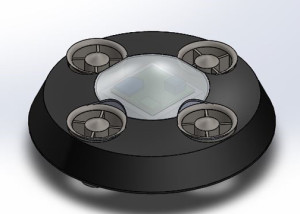By Juan Montano
Hello, this study will try to determine the number of fans that would be required for the UFO. The number of fans used in the UFO must meet the criteria of achieving lift off at 50% +/- ∆.
First, we determined the weight of each component currently provided to us by the customer:
Fan, ECS, Battery, Structure (Old), XBee, Tinyduino, Gyro
| Component |
Weight |
| Fan |
115g +/- 5 |
| ECS |
30g +/- 5 |
| Battery |
380g +/- 5 |
| Structure
(top, mid,bottom) |
400g +/-5 |
| Xbee |
7g +/-5 |
| Tinyduino |
8g +/-5 |
| Gyro |
2g +/- 1 |
Now, we try to determine how the mass of the structure will change as we decrease the number of fans. First, we will assume a linear regression of the diameter size of the UFO as we decrease the number of fans. We will then assume that the correlation between percentage of volume and mass is in a 1:1 ratio.
From a different study, we determined the difference in diameter between 4 & 6 fans was between .7-1.5 inches. Using the max difference, we get ∆d=0.75”. Assume the UFO is a cylindrical shape, we will use the equation of a cylinder to determine the total volume of the UFO. We note that the old structure had d=11” and h=3”.
| Fans |
Volume of UFO |
% Ratio to 6 fans |
Estimated UFO Weight |
| 3 |
|
180.3/284.96*100=63% |
253g |
| 4 |
|
212.5/284.96*100=75% |
298g |
| 5 |
|
247.4/284.96*100= 87% |
347g |
| 6 |
|
284.96/284.96*100= 100% |
400g |
Now we determine the mass (g), and thrust for x number of fans.
| Part/#fans |
3 |
4 |
5 |
6 |
| Fan |
345g |
460g |
575g |
690g |
| ECS |
90g |
120g |
150g |
180g |
| Battery* |
380g |
380g |
380g |
380g |
| Structure** |
253g |
298g |
347g |
400g |
| Xbee |
7g |
7g |
7g |
7g |
| Tinyduino |
8g |
8g |
8g |
8g |
| Gyro |
2g |
2g |
2g |
2g |
| Components |
832g |
977g |
1122g |
1267g |
| Total: |
1085g |
1275g |
1469g |
1667g |
* We will assume a single battery as the power supply for the UFO, given to us from the customer. We may modify this, based on the battery trade-off study.
** Determined above using the old structure
Using the average thrust provided from last semester’s post burn studies, we have 502g of thrust provided by each fan.
| Fans/Thrust |
Total Provided |
Structure+Components=UFO Lift |
UFO Control |
% Control |
| 3 |
1506g |
253+832=1085 |
421 |
28.0% +/-5 |
| 4 |
2008g |
298+977=1275 |
733 |
36.5% +/-5 |
| 5 |
2510g |
347+1122=1469 |
1041 |
41.5% +/-5 |
| 6 |
3012g |
400+1267=1667 |
1345 |
44.7% +/-5 |
For the case of Multiple Batteries:
Here, we will assume that the mass of the battery will change with the amount of fans present. We will use the battery provided by the customer and determine the mass to be 380*x/6, where x is the current number of fans. Therefore, we will have:
| Fans/Thrust |
Total Provided |
For Components |
For Structure |
UFO Lift |
UFO Control |
% Control |
| 3 |
1506g |
642 |
253 |
895 |
611 |
40.6% +/-5 |
| 4 |
2008g |
850 |
298 |
1148 |
852 |
42.4% +/-5 |
| 5 |
2510g |
1059 |
347 |
1406 |
1104 |
44.0% +/-5 |
| 6 |
3012g |
1267 |
400 |
1667 |
1345 |
44.7% +/-5 |
In conclusion, we can see that 6 fans would give us approximately 50% thrust control. However, we would like to point out that there can be modifications made to the battery and/or the structure to provide ourselves with 50% thrust control using a smaller number of fans. Below, we will see how much weight the structure would have to be to provide that requirement.
Appendix A:
Here, we are going backwards to determine the maximum amount of weight our UFO (structure and/or battery combination) should be to provide a 50%+/- ∆ thrust control per number of fans. Using similar assumptions as above, we will note our fixed values.
| Number of fans |
Fixed Thrust |
50% Thrust |
Fixed Weight |
Remaining weight for battery/structure |
| 3 |
1506 |
753 |
452 |
301 |
| 4 |
2008 |
1004 |
597 |
407 |
| 5 |
2510 |
1255 |
742 |
513 |
| 6 |
3012 |
1506 |
887 |
619 |
This table above shows the fixed amount of total thrust we have and the set in weight determined by the components that are required in the UFO (Fan, ECS, Gyro, XBee, Tinyduino) and whose weight we can’t change. The remaining weight column shows how much weight the battery and structure should be to be able to maintain a 50% thrust control.
Since we can allow some leeway in the amount of thrust we should provide for control, we also show a 45% thrust control table below:
| Number of fans |
Fixed Thrust |
55% Thrust |
Fixed Weight |
Remaining weight for battery/structure |
| 3 |
1506 |
828 |
452 |
376 |
| 4 |
2008 |
1104 |
597 |
507 |
| 5 |
2510 |
1380.5 |
742 |
638.5 |
| 6 |
3012 |
1656.6 |
887 |
769.6 |




